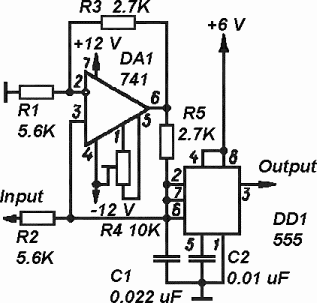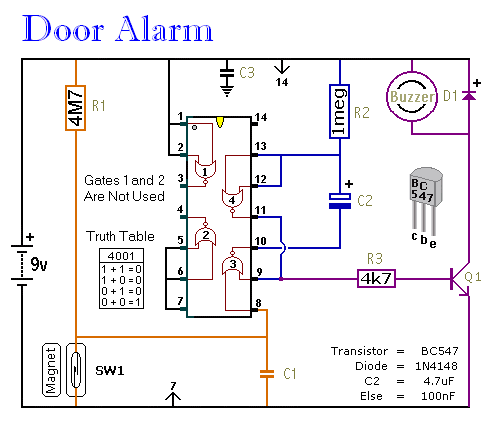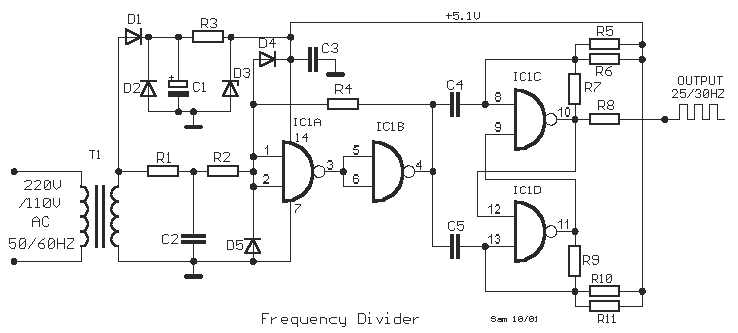
Simple voltage to frequency converter

The timer is utilized in a conventional setup, with the exception that the timing resistor has been substituted with a current source derived from the operational amplifier DA1 (741). This modification enables the achievement of excellent linearity, exceeding 3%. With the selected component values in this circuit, the output frequency will linearly increase from 0 to 21 kHz as the input voltage rises from 0 to 5 V, establishing a frequency output relationship of 4.2 kHz/V in response to the input voltage.
The described circuit employs a timer in a standard configuration, integrating a current source from an operational amplifier (op-amp) to enhance performance characteristics. The op-amp DA1 (741) functions as a current source, replacing the traditional timing resistor. This design choice is significant as it improves linearity, ensuring that the frequency response remains consistent across the specified input voltage range.
The circuit operates by taking an input voltage that varies from 0 to 5 V. As this input voltage changes, the output frequency correspondingly shifts from 0 Hz to a maximum of 21 kHz. The linear relationship between the input voltage and output frequency is quantified by the factor of 4.2 kHz/V, indicating that for every volt increase in input, the output frequency increases by 4.2 kHz.
This configuration is particularly useful in applications requiring precise frequency modulation based on variable input voltages. The choice of the 741 op-amp is a common practice due to its favorable characteristics, such as low offset voltage and good frequency response, making it suitable for this type of timing application. The circuit’s ability to maintain linearity better than 3% further underscores its reliability for precision timing tasks.
In summary, the integration of a current source from the op-amp instead of a resistor not only enhances the linearity of the output frequency but also allows for a broader and more controlled frequency range, which can be critical in various electronic applications.The timer is used in typical configuration, except that the timing resistor is replaced with the current source based on the op-amp DA1 (741). This solution allowed to obtain a good linearity (better than 3%). With the value of components used in this circuit the output frequency will increase linearly from 0 to 21kHz while the input voltage incre
ases from 0 to 5 V (the input voltage controls the output frequency with the relationship 4. 2 kHz/V). 🔗 External reference
The described circuit employs a timer in a standard configuration, integrating a current source from an operational amplifier (op-amp) to enhance performance characteristics. The op-amp DA1 (741) functions as a current source, replacing the traditional timing resistor. This design choice is significant as it improves linearity, ensuring that the frequency response remains consistent across the specified input voltage range.
The circuit operates by taking an input voltage that varies from 0 to 5 V. As this input voltage changes, the output frequency correspondingly shifts from 0 Hz to a maximum of 21 kHz. The linear relationship between the input voltage and output frequency is quantified by the factor of 4.2 kHz/V, indicating that for every volt increase in input, the output frequency increases by 4.2 kHz.
This configuration is particularly useful in applications requiring precise frequency modulation based on variable input voltages. The choice of the 741 op-amp is a common practice due to its favorable characteristics, such as low offset voltage and good frequency response, making it suitable for this type of timing application. The circuit’s ability to maintain linearity better than 3% further underscores its reliability for precision timing tasks.
In summary, the integration of a current source from the op-amp instead of a resistor not only enhances the linearity of the output frequency but also allows for a broader and more controlled frequency range, which can be critical in various electronic applications.The timer is used in typical configuration, except that the timing resistor is replaced with the current source based on the op-amp DA1 (741). This solution allowed to obtain a good linearity (better than 3%). With the value of components used in this circuit the output frequency will increase linearly from 0 to 21kHz while the input voltage incre
ases from 0 to 5 V (the input voltage controls the output frequency with the relationship 4. 2 kHz/V). 🔗 External reference





